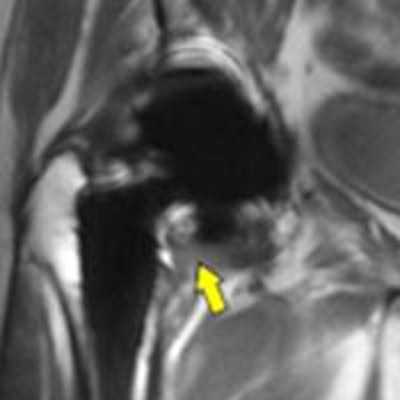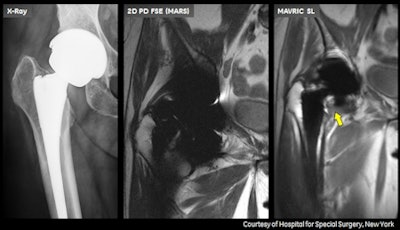
GE Healthcare on May 15 said it plans to begin shipping MAVRIC SL, a combination of MRI acquisition protocol and postprocessing software designed to enhance the accuracy of soft-tissue and bone imaging in patients with metal implants that could make them unsuited for MRI with conventional techniques.
First shown at the RSNA 2011 meeting, MAVRIC SL uses an algorithm that reduces image distortion in the regions near MR-conditional metal implants, enabling physicians to see tissue surrounding an implant to help them with diagnosis, according to the company.
The announcement came on the same day as the release of a study from the Hospital for Special Surgery. Researchers found that MRI can detect inflammation of the joint lining, known as synovitis, in patients with metal-on-metal hip implants long before symptoms appear, allowing for a more conclusive diagnosis and effective planning for follow-up care (Journal of Bone & Joint Surgery, May 15, 2013, Vol. 95:10, pp. 895-902).
 MR images show frontal (left) and cross-sectional (center) views of a patient with a hip implant. MAVRIC SL (right) visualizes the soft tissue around the implant.
MR images show frontal (left) and cross-sectional (center) views of a patient with a hip implant. MAVRIC SL (right) visualizes the soft tissue around the implant."MRI can be used as a screening tool to distinguish those patients with an adverse local tissue reaction," said Dr. Hollis Potter, chief of the division of MRI at the Hospital for Special Surgery. "We also have shown it is the most accurate means by which to assess wear-induced bone loss."
Even in asymptomatic patients, MAVRIC SL technology can recognize an issue that needs to be monitored, Potter said, providing clinical information for an issue that can have significant human and economic costs, particularly when diagnosis is delayed.
According to the U.S. Centers for Disease Control and Prevention, there are more than 1 million hip or knee replacement procedures performed each year in the U.S. In addition, there are more than 250,000 procedures performed annually in Europe, according to the Organization for Economic Cooperation and Development.
The Hospital for Special Surgery and Stanford University collaborated with GE on MAVRIC SL. The protocol received 501(k) clearance from the U.S. Food and Drug Administration (FDA) in December 2012, and it should be available on all GE 1.5-tesla and 3-tesla MRI scanners within the next two months.




















